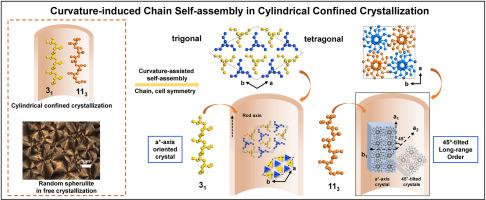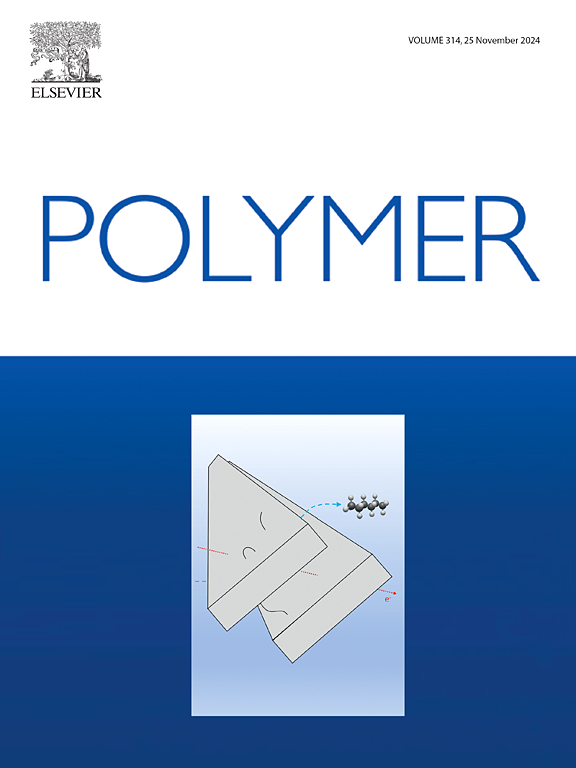聚(1-丁烯)受约束结晶中曲率诱导的 45° 倾斜长程秩
IF 4.1
2区 化学
Q2 POLYMER SCIENCE
引用次数: 0
摘要
本文章由计算机程序翻译,如有差异,请以英文原文为准。


Curvature-induced 45°-Tilted long-range order in constrained crystallization of Poly(1-butene)
Curvature fundamentally alters self-assembly principles in Euclidean space, enabling the formation of unique and more complex structures. The curvature-induced self-assembly of molecular chains under confinement generates novel long-range nanostructures, distinct from the micron-scale spherulites formed in bulk free crystallization. However, few reports have focused on investigating the effect of symmetry on by crystallizing molecular chains at the curved surfaces under nano-confinement, in particular the incompatibility of traditional crystal translational symmetry and curved surface geometry. Here, using poly(1-butene) with 31- or 113-helical chains as a model system, we investigate the impact of chain and unit cell symmetry on curvature-assisted self-assembled nanostructures in cylindrical confinement. The curvature-assisted self-assembled polymer nanostructures have been prepared by infiltrating polymer melts to nanoporous alumina. Two types of ordered nanostructures of poly(1-butene) have been identified via two-dimensional wide-angle X-ray diffraction experiments: trigonal and tetragonal. On one hand, we found that the long-range ordered 45°-tilted tetragonal nanostructures along the cylinder-axis self-assembled with 113 helices in nano-curved spatial constraints. This 45°-tilted crystals are most likely to be epitaxially grown from the a∗-axis crystal (parent crystal) in poly(1-butene). On the other hand, there is no crystal branching for trigonal nanostructure self-assembled with 31 helices under cylindrical confinement. In this case, the a∗-axis of the [001] zone trigonal crystals of poly(1-butene) are consistent with rod-long axis. Our research demonstrates that chain self-assembly in geometrically confined space is an effective method to generate novel long-range ordered polymer nanostructures. The topological constraints imposed by geometric surfaces contribute to the formation of specific long-range ordered nanostructures of polymers, which are closely related to the symmetry of the chains and unit cells in the polymer crystal structure.
求助全文
通过发布文献求助,成功后即可免费获取论文全文。
去求助
来源期刊

Polymer
化学-高分子科学
CiteScore
7.90
自引率
8.70%
发文量
959
审稿时长
32 days
期刊介绍:
Polymer is an interdisciplinary journal dedicated to publishing innovative and significant advances in Polymer Physics, Chemistry and Technology. We welcome submissions on polymer hybrids, nanocomposites, characterisation and self-assembly. Polymer also publishes work on the technological application of polymers in energy and optoelectronics.
The main scope is covered but not limited to the following core areas:
Polymer Materials
Nanocomposites and hybrid nanomaterials
Polymer blends, films, fibres, networks and porous materials
Physical Characterization
Characterisation, modelling and simulation* of molecular and materials properties in bulk, solution, and thin films
Polymer Engineering
Advanced multiscale processing methods
Polymer Synthesis, Modification and Self-assembly
Including designer polymer architectures, mechanisms and kinetics, and supramolecular polymerization
Technological Applications
Polymers for energy generation and storage
Polymer membranes for separation technology
Polymers for opto- and microelectronics.
 求助内容:
求助内容: 应助结果提醒方式:
应助结果提醒方式:


